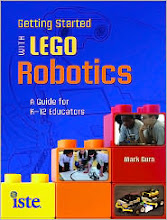"Tech giant Intel backs schoolboy inventor
Mr Banerjee's original Braille printer was made out of Lego robotics parts
A 13-year-old boy from California has
secured funding from Intel to bring a low-cost Braille printer to market.
Intel has not disclosed the exact sum it is giving to Shubham Banerjee, but the Reuters news agency reported it was "a few hundred thousand dollars".
The teenager rose to prominence after showing off a prototype version made with Lego kit, at the White House, when he was aged just 12.
Only a minority of blind people use Braille.
The Royal National Institute of Blind People (RNIB) estimates that about 4% of visually impaired children and young people in England currently use it.
Even so, the charity greeted the news.
"We welcome investment in technology that aims to improve everyday life for blind and partially sighted people, and especially applaud this brilliant initiative from such a young entrepreneur," said Clive Gardiner, RNIB's head of reading and digital services.
"Electronic Braille has great potential, but has been hindered to date by high device costs for users.
"New innovations for low-cost Braille printers such as this one... can transform reading choices for people with sight loss who read Braille.
"We look forward to hearing more about its progress."
Braille 2.0
Until now, Mr Banerjee's company - Braigo Labs - had relied on $35,000 (£21,920) worth of cash from his parents to turn what was originally a science fair project into a proper Silicon Valley start-up.
The original Braigo v1.0 printer used Lego's Mindstorms EV3 robotics kit as well as parts from a local home renovations store.
Users wrote text via an attached keypad, which the machine then converted into Braille, bashing out the raised bumps on a scroll of paper.
The invention won Mr Banerjee several awards and a place at the White House's inaugural Maker Faire in June, attended by President Barack Obama.
He has since begun work on a follow-up version, which is powered by Intel's budget-priced Edison chip and uses 3D-printed parts..."
Read the full story at its source: http://www.bbc.com/news/technology-29920654
ALSO SEE: http://en.wikipedia.org/wiki/Braigo







